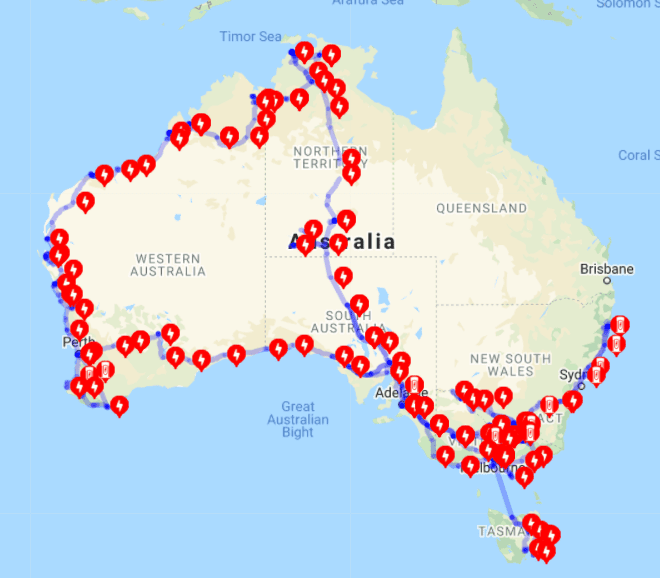Our objective was to travel clockwise around Australia. We didn’t achieve that specific objective, but we had a successful and very enjoyable holiday in our Tesla Model 3 Performance, covering a large part of the country.
We demonstrated that it’s possible to drive an EV widely around Australia and hopefully this will encourage others to plan their own EV adventure. A list of drivers who’ve undertaken ‘around Australia’ drives was recently published on Facebook and it appears we are the 17th to do this.

Holiday comments
A trip like this is a ‘bucket-list’ adventure for so many people. As I mentioned, we both really enjoyed the holiday. We’re fortunate that we could take so much time away and see so much. Although we couldn’t go to Queensland or NSW we were lucky to travel so far during the pandemic.
We found that having a small tent gave us a lot of flexibility when finding accommodation. It’s not for everyone but we enjoyed alternating between the tent and more ‘substantial’ options.
The Kimberley region was a real highlight for me. There is much to see and do, including the Horizontal Falls and Bungle Bungles. Probably our funniest time was also there, at the Derby crab races. And it also had our best accommodation, Echo Beach (Day 38 to 40) – although Fremantle’s Warder’s Hotel was a near second.
My most special memory will be meeting the aboriginal elder in Arnhem Land, Trevor (Day 17), because he challenged my beliefs in ways I won’t elaborate here.
For Steph there is a longer list of highlights. The Olgas and Uluru; various swimming holes and gorges including Emma Gorge and Simpsons Gap; Arnhem land (with Trevor and rock art); Horizontal Falls; Bungle Bungles; Monkey Mia penguins and the Pearl farming boat tour; Fremantle; Ngilgi caves, Margaret River and surrounding region; WA wildflowers; and the diverse range of wildlife and plants we saw throughout.
Our biggest ‘problem’ was probably the Cottesloe accommodation (Day 58).

Vehicle comments
We covered 18,700 kms in 67 days, an average of 280 kms per day.
The car didn’t have a problem despite encountering quite a few corrugated gravel roads and a lot of dust.
The direct cost of charging predominantly occurred at fast chargers. Most of outback charging was without a fee, even when we offered. The total cost was $310, less than 1.7 cents per kilometre.
It has occurred to me that the “wear and tear” on our tyres would be more than our “fuel” costs. Our first set of tyres were replaced after 55,000 kms, not long before our trip, at a cost of $2,500. Our trip was about a third of this distance, so the tyre wear and tear would be about $800.
We charged 152 times (some only for a few moments). We took several charging cables. The most important were:
• 3-phase 32A 5-pin, giving ~11 kW charging rate. (Some other vehicles could achieve 22 kW).
• Single-phase 15A 3-pin (caravan plug), giving ~4 kW.
• Single-phase 10A 3-pin (general power outlet), giving ~2 kW.
We had a 3-phase 20A 5-pin that I used once. A small number of EV chargers require owners to BYO Cable (Type 2 to Type 2) but we found no need to use this because there were alternatives.
We only experienced an “ICE’d charger” once (Eco Beach) but the owner apologised and moved his car immediately when he saw me. We experienced a couple of technical issues – at a few caravan parks where the power wasn’t reliable – we noticed drops in current and voltage; and Chargefox at Horsham stopped before completion (on Day 1) and again (on Day 67); and there was no power at the Hannan St charging in Kalgoorlie.
I took the time to investigate some of the Plugshare facilities. At Daly Waters (Day 14) and Jabiru (Day 19) I encouraged business owners to set up facilities. At a few roadhouses I was politely told that no-one else has ever asked for this, so they have no plans…perhaps no other EV drivers have stopped at these places because there is no charging.
The funniest decline was at Aileron Roadhouse (Day 13). We found two charging points at Derby don’t exist, so had them removed from Plugshare (Day 33). We also did a very quick charge at a couple of charging points that hadn’t had a check in for years, just to verify they are still available.
Other EV comments:
• The furthest we drove in one day was 1,200 kms (Day 67, the final day from Port Augusta to home).
• The vehicle’s maximum range we calculated at 484 km (Day 13 when we drove 392 kms and had 19% charge remaining).
• Our energy usage, on drives of at least 50 kms, varied between 140 Wh/km and 240 Wh/km.
• The impact of a breeze on energy usage was calculated at 20% when we had a head-wind one day and a similar strength tail-wind the next (Days 3 and 4), between Ceduna and Poochera.
To read more about the trip, and the daily blog, and more photos, please look here.


